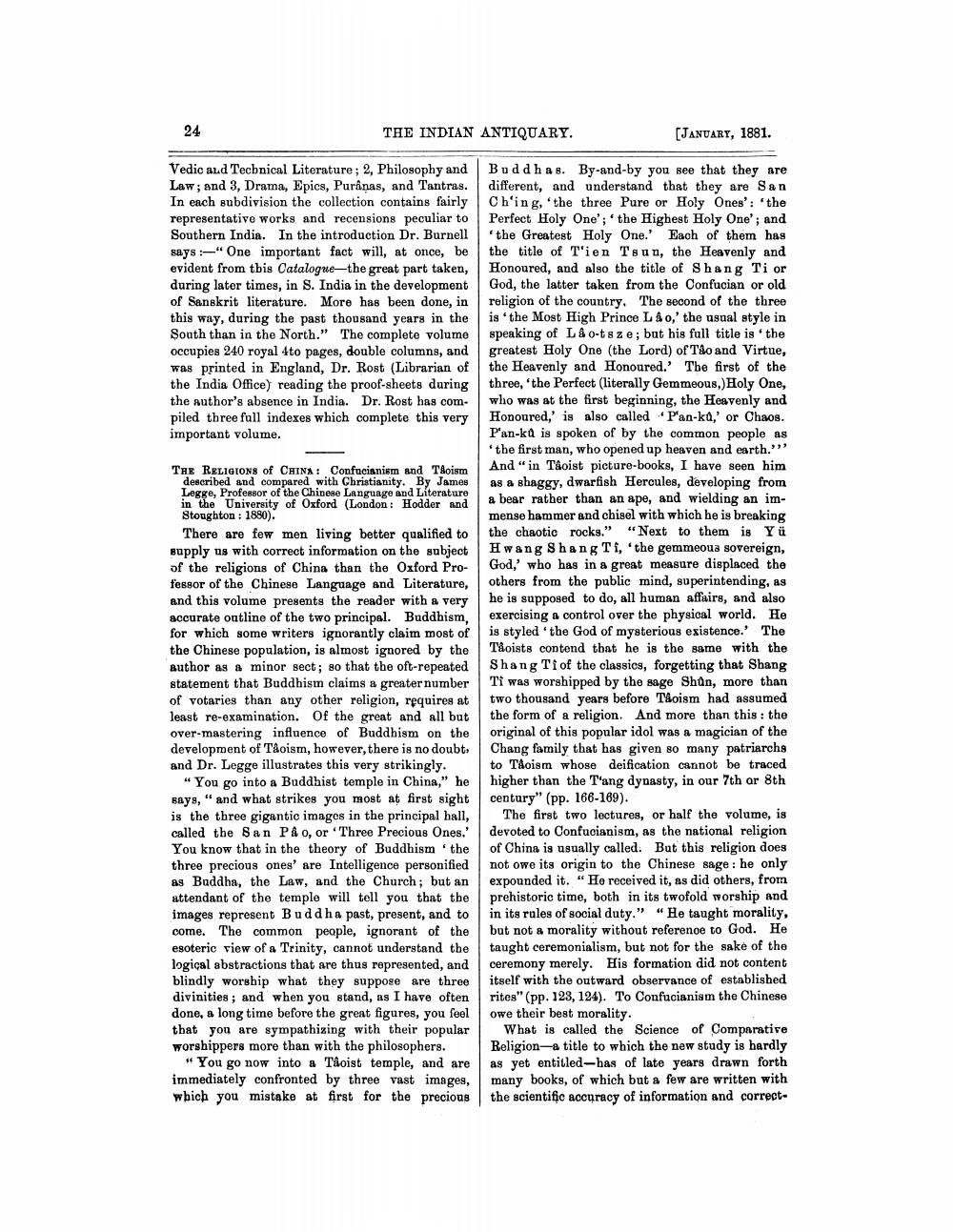________________
24
THE INDIAN ANTIQUARY.
[JANUARY, 1881.
Vedic and Technical Literature; 2, Philosophy and Law; and 3, Drama, Epics, Puranas, and Tantras. In each subdivision the collection contains fairly representative works and recensions peculiar to Southern India. In the introduction Dr. Burnell says :-"One important fact will, at once, be evident from this Catalogue—the great part taken, during later times, in S. India in the development of Sanskrit literature. More has been done, in this way, during the past thousand years in the South than in the North." The complete volume occupies 240 royal 4to pages, double columns, and was printed in England, Dr. Rost (Librarian of the India Office) reading the proof-sheets during the author's absence in India. Dr. Rost has compiled three full indexes which complete this very important volume.
THE RELIGIONS of CHINA: Confucianism and Taoism
described and compared with Christianity. By James Legge, Professor of the Chinese Language and Literature in the University of Oxford (London: Hodder and Stoughton : 1850).
There are few men living better qualified to supply us with correct information on the subject of the religions of China than the Oxford Professor of the Chinese Language and Literature, and this volume presents the reader with a very accurate outline of the two principal. Buddhism, for which some writers ignorantly claim most of the Chinese population, is almost ignored by the author as a minor sect; so that the oft-repeated statement that Buddhism claims a greater number of votaries than any other religion, requires at least re-examination. Of the great and all but over-mastering influence of Buddhism on the development of Taoism, however, there is no doubts and Dr. Legge illustrates this very strikingly.
"You go into a Buddhist temple in China," he says, " and what strikes you most at first sight is the three gigantic images in the principal hall, called the San På o, or Three Precious Ones.' You know that in the theory of Buddhism the three precious ones' are Intelligence personified as Buddha, the Law, and the Church; but an attendant of the temple will tell you that the images represent Buddha past, present, and to come. The common people, ignorant of the esoteric view of a Trinity, cannot understand the logical abstractions that are thus represented, and blindly worship what they suppose are three divinities; and when you stand, as I have often done, a long time before the great figures, you feel that you are sympathizing with their popular worshippers more than with the philosophers.
"You go now into a Taoist temple, and are immediately confronted by three vast images, which you mistake at first for the precious
Buddhas. By-and-by you see that they are different, and understand that they are San Ch'ing, the three Pure or Holy Ones': 'the Perfect Holy One'; 'the Highest Holy One'; and
the Greatest Holy One. Each of them has the title of Tien Tsun, the Heavenly and Honoured, and also the title of Shang Ti or God, the latter taken from the Confucian or old religion of the country. The second of the three is the Most High Prince L a o,' the usual style in speaking of L & o-tsze; but his full title is the greatest Holy One (the Lord) of Tao and Virtue, the Heavenly and Honoured.' The first of the three, 'the Perfect (literally Gemmeous,Holy One, who was at the first beginning, the Heavenly and Honoured,' is also called Pan-ka,' or Chaos. Pan-kd is spoken of by the common people as 'the first man, who opened up heaven and earth." And "in Taoist picture-books, I have seen him as a shaggy, dwarfish Hercules, developing from a bear rather than an ape, and wielding an immense hammer and chisel with which he is breaking the chaotic rocks." "Next to them is Yü Hwang Shang Ti, 'the gemmeoua sovereign, God, who has in a great measure displaced the others from the public mind, superintending, as he is supposed to do, all human affairs, and also exercising a control over the physical world. He is styled 'the God of mysterious existence. The Taoists contend that he is the same with the Shang Ti of the classics, forgetting that Shang Ti was worshipped by the sage Shon, more than two thousand years before Taoism had assumed the form of a religion. And more than this: the original of this popular idol was a magician of the Chang family that has given so many patriarchs to Taoism whose deification cannot be traced higher than the T'ang dynasty, in our 7th or 8th century" (pp. 166-169).
The first two lectures, or half the volume, is devoted to Confucianism, as the national religion of China is usually called. But this religion does not owe its origin to the Chinese sage: he only expounded it." He received it, as did others, from prehistoric time, both in its twofold worship and in its rules of social duty." "He taught morality, but not a morality without referenoe to God. He taught ceremonialism, but not for the sake of the ceremony merely. His formation did not content itself with the outward observance of established rites" (pp. 123, 124). To Confucianism the Chinese owe their best morality.
What is called the Science of Comparative Religion-a title to which the new study is hardly as yet entitled-bas of late years drawn forth many books, of which but a few are written with the scientific accuracy of information and correct




